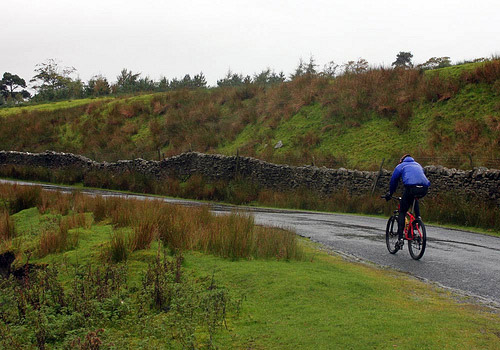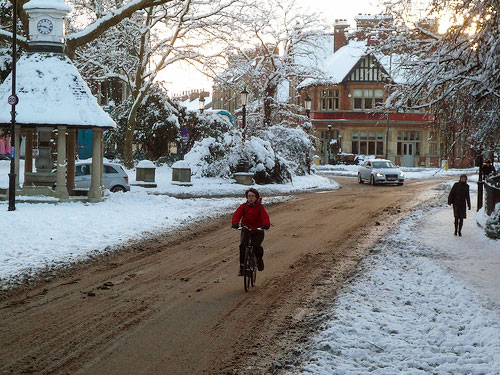
winter cycling
Winter Cycling training is not the most glamorous part of the sport, but it can make a big difference to your performance in the next year. During winter it is good to have the following objectives:
- Gain some rest both physically and mentally (especially if it has been a very hard racing season)
- Build up base aerobic capacity and general fitness.
- Work on core strength and improve all round body condition
- Provide a springboard for more intense training in the spring.
Main Principles of Winter Training
Rest
Many pro-riders take 3 weeks off in November before restarting their winter training. You will lose fitness in this 3 weeks, but there are many psychological benefits of having a complete break, you can soon catch up from 3 weeks off the bike. Personally, I don’t take 3 weeks off in November. I keep riding when weather is good. However, if there is really bad weather, I use it as an excuse to take a week off. Generally, in winter I’m more laid back about training. Other things have a chance to take priority. The key is to listen to your own body and mind. If you’re lacking in enthusiasm and feel tired, definitely it is worth taking a break. If you really want to keep riding, then there’s no reason why not. (see: winter break)
Aerobic Base
Winter is a good time to take a break from intervals and high intensity riding. You don’t want to be racing and doing intervals all year (there’s no prizes for beating your club mates on winter training runs to cafes!) Winter is a good time to ride steady miles and improve your aerobic capacity and endurance. Typically, I ride most of my miles in winter between 60-80% of max heart rate. I don’t monitor it religiously, but I definitely take a break from intervals. See also: Training Periods – splitting up the year into different blocks.
How Many Miles?
A key element of winter training is ‘getting the miles in’. I often ride more miles in winter than I do in summer. Partly, I enjoy cycling so I just enjoy the opportunity to do long rides without worrying about peaking for a race at the weekend. However, if you are doing mainly short races, you don’t need to worry about doing hours and hours of cycling. A good target is to try and do one long ride per week. e.g. if you’re a sportive riding looking to do a 130 mile sportive in the summer. You want to try and be aim to be doing 3-5 hour rides once a week.
Training with other people.
Winter can mean quite a lot of time on the bike in unfavourable weather; it can be difficult to drag yourself out of the warm and on to the cold wet roads. Training with other people is a good way of maintaining motivation. Just a small number of training partners can help provide the incentive to go out when staying in seems more attractive. Look for a local club in your area. It is good to find someone of a similar standard. Try also to avoid the highly competitive winter racer – someone who is always wanting to sprint for road signs, even in the midst of December. Save your racing for summer and the real races.
Core Strength
Winter is a good time to do simple exercises like squats, sit-ups. The aim is to improve strength in different parts of legs. Also, strengthening lower back gives you more strength and capacity to sit on bike for long time. I used to under-estimate the value of this aspect of training. I felt situps and squats wouldn’t make me go faster. But, after picking up a knee injury, a sports physio-therapists discovered some muscles in my leg were weak, causing an imbalance and knee injury. I use some specific exercises, (dealing with knee problems) but even general squats are excellent for improving strength
Diet.
If you gain a few pounds during winter no harm. It is better to just concentrate on eating health and sensible foods, rather than worrying about keeping to your racing weight. At the same time, you don’t want things to get beyond control and see your weight increase significantly. Then it will be a battle to bring your weight back under control. I know one local rider, who in April was desperately trying to lose 10kg and at the same time get really fit for the racing season. It’s a difficult combination to lose weight and gain power at same time; therefore, don’t let it go over winter!
Finding Time
After the clocks go back, it’s much harder to find daylight to do training. If possible, try and incorporate commuting into your training. It’s a good time-efficient way of getting a few more steady miles in. For the super keen – one hour on the turbo is an excellent way of keeping the legs ticking over in the middle of the weak.
Motivation
This is the key for winter cycling training. Find ways to motivate yourself throughout the dark winter months. Have a mileage chart and try to keep to certain targets. Mix up your training, and if possible try to go on a winter training camp and give yourself a break from the English weather.
Cross Training
In winter, you can take the opportunity to do some cross training. Something like swimming is very good because it is easy on the joints. I don’t do much cross training, though I do enjoy running up stairs every now and then (see also: Running v Cycling)
Personal Account
Usually, in October I have a very intense hill climb season. This means lots of intervals and high intensity racing, but not that many miles. Therefore in November and December, I take a break from any intervals and concentrate on steady miles. I don’t like trundling along at 15 mph on long slow club runs. I like to keep up a decent pace; often I average between 17 and 18 mph. The main thing is to stay inspired and enjoy your winter cycling. My target is often:
- 800 miles November
- 700 miles December
- 800 miles January
- 900 miles February
but, if my mileage falls short no harm. I don’t do many races over 50 miles anyway.
What training do you like to do over winter?
Related



Winter training – I have come across a number if differing view points,
I tend to take your position – in not stopping cycling but lower the intensity.
I have been recommended a training plan in the ‘Black Book’ as my fellow club members call it.
Three days turbo training in the week – and one or perhaps two longer rides at week end, weather permitting.
All steady rides to work on base fittness.
However, I have not really had any time off, well no off time at all to tell the truth.
I am taking your stance, gambling on some later bad weather to allow a slow down or a few day off,
I do like most find it difficult to face more the 2 hrs on the ‘rack’ (I am fairly new to serious cycling, 2 years, I am now understanding the origins of some of the cycling jargon, i.e. the rack)
1 hr is bad enough.
Hopefully the winter weather will not be a bad as last year.
I enjoy reading other riders views and opinions on Riding and training it tends to boost my own motivation.
Roll on next season, hopefully fitter and faster.
cheers, Barrie agree it’s inspiring to read other riders views on training
Over the last winter I didn’t ride as much as I should and it took me awhile to see improvements in time trials this year. Eventually I did see results but I’m hoping to approach this winter a lot better. Currently planning training to build up my aerobic base and losing fat while not doing too much intensive training.
If the roads are too dangerous with ice/snow will you use the turbo? Would you still do long 60-80% rides or some kind of intervals? I find the turbo mind numbing for anything over an hour.
Thanks for insight into your winter training.
Hi Tom, I agree that turbo training is dull (especially for base training). I might do a couple of hours if there is a really prolonged period of ice and snow. But, generally I keep riding in November when weather is good. My winter break occurs when weather is really bad!
I also hope to do more over winter for an even better year next year.
Thanks for the motivation! Guilty of being a fair weather cyclist.
Pictures of cyclists in winter waters down my excuses…
cheers James. Sometimes winter riding can be great, but not always!